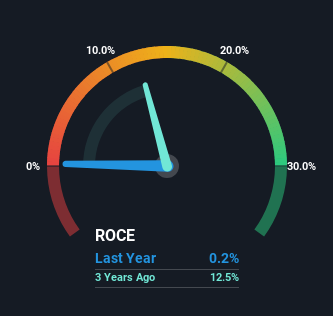- Hong Kong
- /
- Trade Distributors
- /
- SEHK:8080
North Asia Strategic Holdings (HKG:8080) Will Be Hoping To Turn Its Returns On Capital Around

If you're not sure where to start when looking for the next multi-bagger, there are a few key trends you should keep an eye out for. Amongst other things, we'll want to see two things; firstly, a growing return on capital employed (ROCE) and secondly, an expansion in the company's amount of capital employed. This shows us that it's a compounding machine, able to continually reinvest its earnings back into the business and generate higher returns. Although, when we looked at North Asia Strategic Holdings (HKG:8080), it didn't seem to tick all of these boxes.
Return On Capital Employed (ROCE): What Is It?
Just to clarify if you're unsure, ROCE is a metric for evaluating how much pre-tax income (in percentage terms) a company earns on the capital invested in its business. The formula for this calculation on North Asia Strategic Holdings is:
Return on Capital Employed = Earnings Before Interest and Tax (EBIT) ÷ (Total Assets - Current Liabilities)
0.0019 = HK$2.9m ÷ (HK$2.1b - HK$589m) (Based on the trailing twelve months to March 2023).
Thus, North Asia Strategic Holdings has an ROCE of 0.2%. In absolute terms, that's a low return and it also under-performs the Trade Distributors industry average of 4.5%.
See our latest analysis for North Asia Strategic Holdings

Historical performance is a great place to start when researching a stock so above you can see the gauge for North Asia Strategic Holdings' ROCE against it's prior returns. If you want to delve into the historical earnings, revenue and cash flow of North Asia Strategic Holdings, check out these free graphs here.
What Does the ROCE Trend For North Asia Strategic Holdings Tell Us?
When we looked at the ROCE trend at North Asia Strategic Holdings, we didn't gain much confidence. Over the last five years, returns on capital have decreased to 0.2% from 13% five years ago. On the other hand, the company has been employing more capital without a corresponding improvement in sales in the last year, which could suggest these investments are longer term plays. It may take some time before the company starts to see any change in earnings from these investments.
On a side note, North Asia Strategic Holdings has done well to pay down its current liabilities to 28% of total assets. So we could link some of this to the decrease in ROCE. What's more, this can reduce some aspects of risk to the business because now the company's suppliers or short-term creditors are funding less of its operations. Some would claim this reduces the business' efficiency at generating ROCE since it is now funding more of the operations with its own money.
The Bottom Line
To conclude, we've found that North Asia Strategic Holdings is reinvesting in the business, but returns have been falling. And investors appear hesitant that the trends will pick up because the stock has fallen 63% in the last five years. Therefore based on the analysis done in this article, we don't think North Asia Strategic Holdings has the makings of a multi-bagger.
One more thing: We've identified 5 warning signs with North Asia Strategic Holdings (at least 2 which are a bit unpleasant) , and understanding them would certainly be useful.
If you want to search for solid companies with great earnings, check out this free list of companies with good balance sheets and impressive returns on equity.
Valuation is complex, but we're here to simplify it.
Discover if North Asia Strategic Holdings might be undervalued or overvalued with our detailed analysis, featuring fair value estimates, potential risks, dividends, insider trades, and its financial condition.
Access Free AnalysisHave feedback on this article? Concerned about the content? Get in touch with us directly. Alternatively, email editorial-team (at) simplywallst.com.
This article by Simply Wall St is general in nature. We provide commentary based on historical data and analyst forecasts only using an unbiased methodology and our articles are not intended to be financial advice. It does not constitute a recommendation to buy or sell any stock, and does not take account of your objectives, or your financial situation. We aim to bring you long-term focused analysis driven by fundamental data. Note that our analysis may not factor in the latest price-sensitive company announcements or qualitative material. Simply Wall St has no position in any stocks mentioned.
About SEHK:8080
North Asia Strategic Holdings
An investment holding company, engages in the hi-tech distribution and services, electronic payment solution, and leasing businesses in Hong Kong, the People’s Republic of China, and rest of Asia.
Adequate balance sheet and slightly overvalued.
Market Insights
Community Narratives




